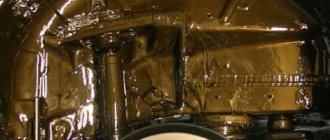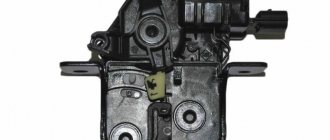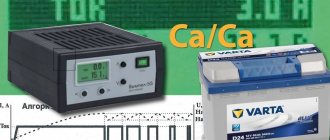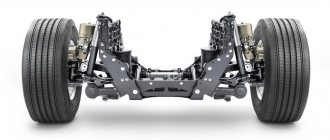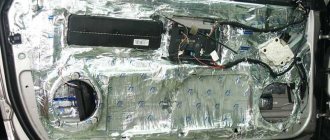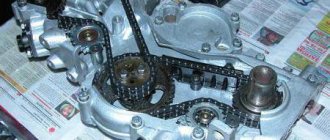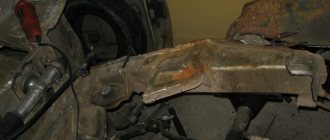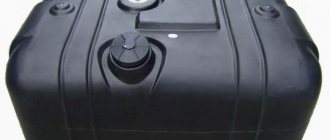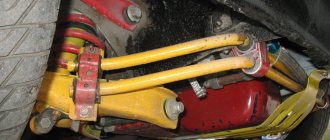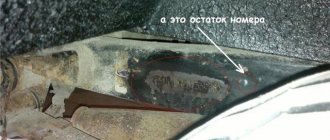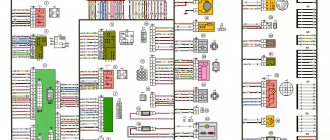Author: Evgeny Zhivoglyadov. Date of publication: March 24, 2022. Category: Automotive equipment.
Changes in weather, temperature conditions, widespread use of reagents and other environmental influences negatively affect the condition of the car. But the main enemy of any car is moisture. Under its influence, corrosion quickly forms on the bottom, door arches and other parts of the vehicle, which quickly grows and provides the car owner with headaches and constant costs.
Of course, today in the store you can find specialized mastics, inhibited mixtures and other compounds that can form a protective film on a car. But they are expensive and dry quickly. That's why there's nothing better than good old cannon fat. No matter how hard auto chemical manufacturers try, this composition remains the most powerful amulet for the body against rust.
Types of funds
The set makes up an impressive list, but we will limit ourselves to the names of liquid funds. The list is:
- practice-tested mastics;
- inhibited compositions containing molecular inclusions of petroleum products that form protective films;
- oils that prevent oxygen from penetrating metal components and parts;
- lubricants with universal plastic properties.
The last resort is pushsalo. Practice has proven that pushsalo will be an effective talisman for body metal against rust. It is enough to apply a thin layer of a protective product on metal surfaces so that the feeling of fear for your car will forever disappear from the driver’s soul.
For example, the bottom of the car will become inert to the effects of rain, melt water, dust, impacts of small pebbles, and road salt from ice. That is, treatment with cannon fat will become a panacea for all negative road misfortunes.
Instructions for correct application
To properly process a car, you need to prepare cannon lard of the selected brand in a volume of 1-2 liters per car, as well as a set of consumables and tools:
- heat source - gas burner, electric stove, hair dryer, any other for heating lard;
- a container for dispensing lubricant from a large canister, which does not make sense to heat;
- degreaser – white spirit, acetone;
- brush, spray gun for applying lard;
- sandpaper if there are already traces of rust on the surface of the parts (needed to remove them).
Preparatory work
As preparation measures, you need to put in order all the details that will be processed:
- remove plastic elements;
- wash the body, dry it, degrease it;
- remove existing rust.
In order for the lard to acquire the desired consistency, it must be diluted to a liquid state, then heated. Usually the lubricant is diluted with gasoline, which can be poured in an amount of 10-20% of the total mass to form a liquid, homogeneous product. Afterwards, the cannon fat is heated to +90 degrees, when the process of melting begins. The fire must be slow to avoid dangerous consequences. The mass is constantly stirred when heated, otherwise it may separate. If you plan to spray the composition with a spray gun, it is recommended to add a little motor oil to it.
Applying gun lard
A large container is placed on the floor of the inspection pit so that the remaining lard flows into it and not onto the floor. If you use a brush for application, try to make wide strokes, which will help to evenly distribute the fluff over the surface of the part. A layer thickness of 0.3-0.4 mm is sufficient, and if the layer is too thin, go over the base again. The easiest way to pour material into thresholds, door openings, and technological holes is with a syringe. After applying the composition proceed as follows:
- dry the car naturally for 1-2 hours;
- return all removed parts to their place;
- start using the car.
Places for processing
Usually, preservation is carried out in those places where moisture tends to accumulate. These include welds, joints of elements, arches, various cavities and voids. Push salo is not used in the car interior, because it has an unpleasant odor.
How to wash off gun fat
Cannon lard is not washed off with water because it does not dissolve in it. However, there are situations when there is a need to remove it from the metal surface. If the drying time of the composition has not yet ended, you can wipe it off with a rag: this is usually required if the application is careless. After mechanically removing most of the grease, the rest can be washed with laundry soap.
To remove unnecessary smears of dried fat, it is recommended to use acetone or any other solvent.
But the latter are capable of dissolving the paintwork itself, so you must act with extreme caution. Another option for cleaning the surface from pushsal is to combine kerosene and gasoline (60% and 40%), lubricate the metal with this product, then wipe off the remaining grease with a cloth and soap.
Composition of pushsala
First, let's figure out what cannon fat is.
The basis of the anti-corrosion product is oil obtained from petroleum.
Thickeners are petrolatum and ceresin. Various additives that inhibit chemical corrosion reactions increase the positive properties. Pushsalo is a universal protective consistency. Similar in viscosity to paraffin or lithol of high density.
Drivers love anticorrosive for its affordable price and unique properties. Using a push salo, the driver is able to apply a protective layer on his own. The main thing is to do the job well.
Purchase and storage
If you purchased a container of gun lard and applied some of the lubricant to metal surfaces, do not rush to throw away the remaining material
An important feature of the composition is its ability for long-term storage. In a tightly closed package, the lubricant will not lose its protective properties even after 5-10 years of storage
Here, a lot depends on the conditions in which the cannon fat was stored and what the temperature was inside the room. Some argue that cannon lard has no expiration date at all. This is a controversial statement, since if stored improperly, it loses its physical and chemical properties. But if you adhere to the rules, then you can really use the pushsal again in 10, or even 20 years. This has been proven in practice by motorists who found their grandfather’s supplies of lubricant, and after so many years it looked and worked like it had just been purchased.
The cost depends on the manufacturer and volume. But cannon lard is a budget type of lubricating preservative materials. A container of 35-40 kilograms will cost the buyer approximately 2.5 thousand rubles. Small banks are also sold, the price of which does not exceed 400-500 rubles. But the question of where to get real cannon fat, and not its modern parodies, also remains relevant. If you ask this question to an experienced motorist, he will recommend going to the military store or places where you can purchase products from an army warehouse. Previously, finding such a lubricant was not difficult. It was supplied in tin cans. Since the products were used for the needs of the army, there were no questions about quality.
Nowadays, there is no need to look for an accommodating warrant officer who is ready to give a can of cannon fat for a certain reward. It is sold under the trademarks of various companies engaged in oil refining and the manufacture of petroleum products. Now pushsalo is as affordable as litol, solid oil or movil
It is important to take into account the presence of a certificate. If you want to purchase lubricant manufactured in accordance with GOST, then look for cans with PVK lubricant and the designation 19537-74
The pushsalo is also sold under the TU sign. This means that the manufacturer used its own formulations to produce the lubricant. Although the experience of drivers shows an insignificant difference in the quality of lubricants made according to technical specifications, in comparison with those made according to GOST.
The supplies remaining in military warehouses are still being actively sold to citizens. And don’t think anything bad. Such sales are carried out in full compliance with the law. Cannon lard, produced for the needs of the Ministry of Defense, is supplied in tin cans. Their volume is 20 liters. The nuance is that it is allowed to store a push salo for military needs for no more than 5 years. When the term expires, it is put up for sale. Since the actual shelf life exceeds 10 years, buying lubricant at military sales is very profitable.
Properties of cannon lard
Previously, this product was called cannon artillery lard. Treating your car with gun fat yourself is not particularly difficult.
It has the following properties:
- The consistency repels water one hundred percent;
- According to the method of application, it acts universally, i.e. it equally protects ferrous and non-ferrous metals from corrosion.
- Does not lose properties at low (-50 C°) or high temperatures (+50 C°).
For military purposes, the lubricant was previously used to preserve small arms and artillery weapons.
Instructions for correct application
To properly process a car, you need to prepare cannon lard of the selected brand in a volume of 1-2 liters per car, as well as a set of consumables and tools:
- heat source - gas burner, electric stove, hair dryer, any other for heating lard;
- a container for dispensing lubricant from a large canister, which does not make sense to heat;
- degreaser – white spirit, acetone;
- brush, spray gun for applying lard;
- sandpaper if there are already traces of rust on the surface of the parts (needed to remove them).
Preparatory work
As preparation measures, you need to put in order all the details that will be processed:
- remove plastic elements;
- wash the body, dry it, degrease it;
- remove existing rust.
In order for the lard to acquire the desired consistency, it must be diluted to a liquid state, then heated. Usually the lubricant is diluted with gasoline, which can be poured in an amount of 10-20% of the total mass to form a liquid, homogeneous product. Afterwards, the cannon fat is heated to +90 degrees, when the process of melting begins. The fire must be slow to avoid dangerous consequences. The mass is constantly stirred when heated, otherwise it may separate. If you plan to spray the composition with a spray gun, it is recommended to add a little motor oil to it.
Applying gun lard
A large container is placed on the floor of the inspection pit so that the remaining lard flows into it and not onto the floor. If you use a brush for application, try to make wide strokes, which will help to evenly distribute the fluff over the surface of the part. A layer thickness of 0.3-0.4 mm is sufficient, and if the layer is too thin, go over the base again. The easiest way to pour material into thresholds, door openings, and technological holes is with a syringe. After applying the composition proceed as follows:
- dry the car naturally for 1-2 hours;
- return all removed parts to their place;
- start using the car.
Places for processing
Usually, preservation is carried out in those places where moisture tends to accumulate. These include welds, joints of elements, arches, various cavities and voids. Push salo is not used in the car interior, because it has an unpleasant odor.
How to wash off gun fat
Cannon lard is not washed off with water because it does not dissolve in it. However, there are situations when there is a need to remove it from the metal surface. If the drying time of the composition has not yet ended, you can wipe it off with a rag: this is usually required if the application is careless. After mechanically removing most of the grease, the rest can be washed with laundry soap.
To remove unnecessary smears of dried fat, it is recommended to use acetone or any other solvent.
But the latter are capable of dissolving the paintwork itself, so you must act with extreme caution. Another option for cleaning the surface from pushsal is to combine kerosene and gasoline (60% and 40%), lubricate the metal with this product, then wipe off the remaining grease with a cloth and soap.
Preparatory work before processing
When starting work, it is necessary to prepare tools and take safety precautions. Self-treatment of a car begins with the purchase of a lubricant product. There is no point in purchasing cannon lard for future use, since it is easy to buy at any auto store. Available in 2 or 5 liter capacities. Usually it takes 1 kg per car.
They stock up on a heat generator - an electric stove, a special gas burner for heating the mixture. Preparing containers for anticorrosion. The areas where the consistency is applied are degreased using white spirit.
Place brushes and spray guns in a convenient place. The last element is connected to a household compressor. It is important to stock up on sandpaper to remove any detected corrosion stains. Abrasive paper is used to attack rust. The presence of a fire extinguisher at the machine processing site is a mandatory requirement.
When the instruments are prepared for work, they begin to heat the product. It is important to bring the cannon fat to a liquid state (+90 C°). For safety reasons, you should not use open fire. Possible fire. It will be better when heated on an electric stove.
You should pay attention to the following point. Before heating, the consistency should be diluted with gasoline. It is rational to use the product only diluted, since this is how a homogeneous product is obtained. When heating the composition, you should stir it continuously.
Car treatment
Plastic items are removed from the car. Thoroughly clean the body of dirt and dust. Corrosion stains are protected with sandpaper. Then degreasing is carried out. Use inexpensive white spirit or its equivalent. Then the metal parts of the body are coated with diluted oil. It is more convenient to handle with a regular brush. Using broad strokes, distribute the finished product evenly over all areas.
Some drivers use sprayers to treat car bodies. Then machine oil is integrated into the consistency. Syringes are also used to seal voids.
Apply a thin layer of pushsalo to the bottom. After drying for an hour, you can operate the car in severe weather conditions. The consistency will be of high quality if you know how to dilute the cannon lard.
Places for processing
Apply the product to arches, cavities, and seams after welding. That is, it preserves places where moisture accumulates.
It is not recommended to use the consistency inside the cabin due to the unpleasant pungent odor.
Anti-corrosion protection must be applied to a well-protected, dried metal surface. If you neglect the rule, it is easy to run into trouble - a chemical corrosion reaction under the protective layer will begin to develop momentum. This is already really bad.
Requirements for anti-corrosion coating
The correct anticorrosive agent must have the following properties:
- Form an elastic film on a metal surface.
- Possess a high degree of adhesion - adhesion of various surfaces in solid or liquid form.
- Impregnate not only smooth surfaces, but also penetrate into cracks and depressions.
- Displace accumulated moisture.
- Wet the surface well.
- Should not dry out.
- Do not form cracks where water can penetrate.
- No special surface preparation is required.
- Be resistant to the mechanical effects of small particles rising from the road surface - gravel, sand, pebbles.
- Be resistant to temperature changes and maintain its characteristics at any time of the year.
The use of cannon tallow satisfies these requirements and creates reliable insulation from the environment. The composition of cannon lard is petroleum oil, which is thickened with petrolatum and ceresin. To ensure performance properties, an anti-corrosion additive is added.
The coating received its name due to the fact that it was first used to preserve artillery weapons, including guns.
Benefits of cannon lard
Main features of the substance:
- high degree of elasticity;
- ability to stay on the surface without rolling off during application and further use;
- lack of interaction with water, which allows it to be successfully used on the bottom of a car;
- temperature range of use – from minus 50° to plus 50°C;
- protection against corrosion when exposed to sea water and salt fog;
- Application area: ferrous and non-ferrous metal surfaces.
Visually it is a homogeneous ointment-like mass with a color ranging from yellow to light brown. Sold in metal cans or buckets of various capacities. Packaging starts from 1 kg.
The price of this type of anti-corrosion coating is very affordable. For comparison, the table shows the cost depending on volume and manufacturer.
Preparation
Before applying the coating, you should prepare everything you need. To carry out anti-corrosion treatment you will need:
- cannon fat in a jar or bucket;
- breeding agent;
- electric stove or hair dryer;
- paint brush;
- syringe.
We should especially talk about the breeding agent. There are several options for diluting cannon fat to a liquid state.
For this the following can be used:
- petrol;
- solvent;
- used oil;
- Movil;
- anti-corrosion agent like RUST STOP.
Each of them has its own disadvantages and advantages. The solvent will cost a little more. The processing properties depend on what kind of oil was originally used.
Anti-corrosion agent RUST STOP is one of the substances that successfully fights metal corrosion. Manufacturer: Canadian.
The advantage of RUST STOP is that it never freezes. Being in a semi-liquid state, this product fills all cracks and scratches on the metal surface without damaging the rubber parts. A layer of corrosion inhibitors reliably protects the surface from rust.
This anti-corrosion agent does not require particularly careful preparation of the surface to be treated - it can be applied over a slight layer of rust. As a result, the anti-corrosion treatment technology is significantly simplified and the time for the entire process is reduced. An additional bonus is that the manufacturer uses various fragrances, for example, cherry or strawberry.
Mode of application
First you need to prepare the car. It is necessary to remove all plastic parts that interfere with operation. Rinse the surfaces that will be protected. Remove traces of corrosion. Degrease the surface by wiping it with white spirit.
Then you should prepare the cannon fat. This work consists of heating it and bringing it to the consistency of thick sour cream. You can heat it on an electric stove, stirring constantly. It is also possible to use a hair dryer.
About two minutes after the end of heating, add a solvent or anti-corrosion agent to the melted lard in a ratio of 4:1. The solution is ready for use.
On large surfaces the solution is applied with a paint brush. Treating the underbody of a car with cannon fat requires that the car must be raised on jacks. It will be even more convenient to work while in the inspection hole.
It is wise to place a container below where the excess will drain or drip. Apply cannon lard to the surface using broad strokes. Each layer should be 0.3-0.4 mm thick. When it comes into contact with a cold car, the lard sets quickly. After hardening, you can apply another one on top.
What is better to use - reviews from car owners?
On the Internet, in automobile forums, drivers constantly argue about what is better to use when treating a car, lard or Movil. There is no clear answer given. Optimists agree with the opinion of drivers who strongly support Movil. Domestic Movil has gained fame as a cheap product. Its use can be said to be nationwide, if by this word we mean exclusively motorists.
Millions of drivers annually face the problem of corrosive chemical reactions that occur in the car body. Inexpensive Movil helps solve problems. The anti-corrosion product was developed in laboratories in Vilnius and Moscow.
The molecular structure includes:
- machine oil;
- drying oil;
- corrosion inhibitors.
The quality of the product is comparable to European analogues. For liquefaction, they used to dilute with kerosene or white spirit. Many drivers do this now - it’s easier to apply the product to the metal surfaces of the body. Movil's molecular structure contains inclusions of substances that prevent contact of air and moisture with the metal. It turns out that if a domestic product is applied to the body metal parts, the car can be operated in difficult climatic conditions without fear of corrosion.
Instructions for correct application
To properly process a car, you need to prepare cannon lard of the selected brand in a volume of 1-2 liters per car, as well as a set of consumables and tools:
- heat source - gas burner, electric stove, hair dryer, any other for heating lard;
- a container for dispensing lubricant from a large canister, which does not make sense to heat;
- degreaser – white spirit, acetone;
- brush, spray gun for applying lard;
- sandpaper if there are already traces of rust on the surface of the parts (needed to remove them).
Preparatory work
As preparation measures, you need to put in order all the details that will be processed:
- remove plastic elements;
- wash the body, dry it, degrease it;
- remove existing rust.
In order for the lard to acquire the desired consistency, it must be diluted to a liquid state, then heated. Usually the lubricant is diluted with gasoline, which can be poured in an amount of 10-20% of the total mass to form a liquid, homogeneous product. Afterwards, the cannon fat is heated to +90 degrees, when the process of melting begins. The fire must be slow to avoid dangerous consequences. The mass is constantly stirred when heated, otherwise it may separate. If you plan to spray the composition with a spray gun, it is recommended to add a little motor oil to it.
Applying gun lard
A large container is placed on the floor of the inspection pit so that the remaining lard flows into it and not onto the floor. If you use a brush for application, try to make wide strokes, which will help to evenly distribute the fluff over the surface of the part. A layer thickness of 0.3-0.4 mm is sufficient, and if the layer is too thin, go over the base again. The easiest way to pour material into thresholds, door openings, and technological holes is with a syringe. After applying the composition proceed as follows:
- dry the car naturally for 1-2 hours;
- return all removed parts to their place;
- start using the car.
Places for processing
Usually, preservation is carried out in those places where moisture tends to accumulate. These include welds, joints of elements, arches, various cavities and voids. Push salo is not used in the car interior, because it has an unpleasant odor.
How to wash off gun fat
Cannon lard is not washed off with water because it does not dissolve in it. However, there are situations when there is a need to remove it from the metal surface. If the drying time of the composition has not yet ended, you can wipe it off with a rag: this is usually required if the application is careless. After mechanically removing most of the grease, the rest can be washed with laundry soap.
To remove unnecessary smears of dried fat, it is recommended to use acetone or any other solvent.
But the latter are capable of dissolving the paintwork itself, so you must act with extreme caution. Another option for cleaning the surface from pushsal is to combine kerosene and gasoline (60% and 40%), lubricate the metal with this product, then wipe off the remaining grease with a cloth and soap.
Useful tips
It is recommended to apply the composition not only to the arches, but also to the seams after welding. This way we preserve the places most susceptible to moisture accumulation. There are some more tips:
- If you use gasoline or other odorous compounds, you should not treat surfaces inside the car with gun fat. Otherwise, you will have to suffer for a long time from the unpleasant odor that will be absorbed into the upholstery.
- Although cannon fat can withstand +50 degrees, often already at +40 the mass begins to “slip”. Therefore, if you live in a region with a hot climate, it is recommended to add ceresin 67 or 80 (up to 5%) or a little ceresin oxide. This will prevent the composition from rolling off, and it will remain stable even at +50 degrees.
- If you plan to apply gun oil at an ambient temperature of +10 or below, then you need to be prepared for the composition to thicken too quickly. Therefore, it is very difficult to apply it with a brush.
- Wear protective gloves while working and do not allow gun grease to come into contact with your eyes or skin. It is recommended to carry out processing in a warm and well-ventilated area (especially if you are using gasoline).
Are there any downsides?
The main disadvantages of cannon fat are:
- Due to the insufficient amount of inhibitors in the composition, the product is more suitable only for treating new cars without obvious rust spots. If you apply it directly to rust, then due to the lack of ventilation the iron will begin to rot more intensively.
- In addition, the negative property of this product is stickiness, so dust sticks quite strongly to the protective surface.
- To blow it into hidden internal cavities, special equipment is required. At a temperature of approximately +10 degrees, the liquid composition begins to thicken quickly, so applying it with a brush is quite problematic.
Today, the automotive market offers many compounds for anti-corrosion treatment. Cannon lard is one of the cheapest options that gives long-lasting results.
Author: Baranov Vitaly Petrovich
Education: secondary specialized. Specialty: car mechanic. Professional diagnostics, repair, maintenance of passenger cars of foreign production 2000-2015. Extensive experience working with Japanese and German cars.
Scope of application
Since gun lard has excellent anti-corrosion properties, there are no big questions regarding the scope of application of this lubricant. It is actively used in various household and economic industries, and is also regularly used when processing the body and underbody of vehicles. In general, cannon lard can be applied to various metal surfaces, regardless of shape, size or other parameters. The preservative properties of pushsal allow it to successfully exert its protective effect on the processed non-ferrous and ferrous types of metal. But it is important to consider that, like any other protective lubricant, with regular and direct exposure to sunlight, precipitation and temperature changes, the properties of gun fat will gradually fade away. It is necessary to periodically renew the protective layer to prevent the possible formation and spread of rust on metal surfaces.
Gun lard has decent characteristics, thanks to which it is so often used for working with various types of metals. Depending on operating conditions, the intensity of metal wear and external influences, a protective coating made of pushsala can last 3-10 years without losing its effectiveness. The operating temperature range for this lubricant is from -50 to +50 degrees Celsius. This makes it possible to use cannon fat in almost all regions. Only with incorrect application or with overly aggressive action can cracks appear on the surface treated with lard. It is worth adding that the material is characterized by the property of not dissolving in water. This allows you to wash your car multiple times, even with a powerful jet of water. After removing the contaminants, the gun fat will still remain on the surface of the metal and will not lose its protective properties.
Price
On average, the price of PVC lubricant is relatively low. For example, for a 39-kilogram drum of cannon fat you will have to pay about 2.5 thousand rubles. True, this amount of lubricant can be used to treat at least a couple of truck tractors, not to mention passenger cars. There are smaller containers - the cost for them varies from 400 to 1.5 thousand rubles, depending on the manufacturer and the volume of the drum itself.
